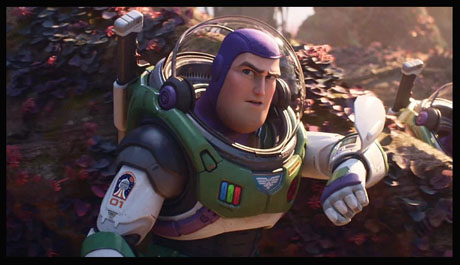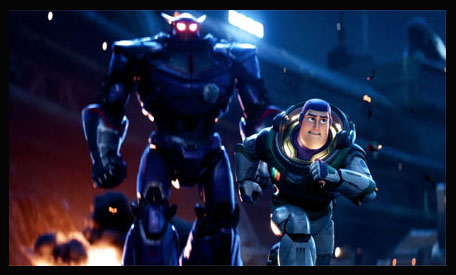
We all remember that 27 years ago, a boy named Andy received a futuristic spaceman action figure as a gift. As he was known, Buzz Lightyear joined a coterie of toys, completing the main cast of Pixar’s Toy Story franchise. Although Buzz seemed to come complete with a background story as a stalwart Space Ranger, it has only now been revealed that he was the star of a movie that was seen by Andy (his favorite one) that spawned the line of toys. Lightyear purports to be that movie.

Two things are immediately called into question: The first is relatively minor compared to the second. Andy could not see a movie made like this before 1995 since Lightyear combines the incredible abilities of Pixar’s Presto CGI animation program with some assistance from Renderman. The lighting, sets, CGI constructs, and SFX showcase some of the most extraordinary achievements ever to appear in a Pixar film. Maybe it should have been announced that this is the remastered version. Second, this is not the same Buzz Lightyear we saw in Toy Story. Much of the character that appeared in the 1995 film has been altered, and not always for the better.
In the original movie, Buzz Lightyear was a delusional toy that believed himself to be a heroic Space Ranger, providing humor and charm throughout the film. His main antagonist was not Zurg, but Woody, who had his role as Andy’s favorite toy usurped. Not until Buzz crashes to the ground in a futile attempt to fly from a high window does reality sink in.
The protagonist of Lightyear is, by contrast, a dour figure obsessed with fixing a flight path mistake that led to a crash (and to a colony of travelers seeking an inhabitable planet stranded on a distant world called T’Kani Prime). Buzz’s miscalculations in producing a good hyperspace fuel source that could enable the disabled ship to return to Earth result in a “time dilation”; every time he attempts a test flight, four minutes pass for him while four years pass on the planet below.

The stubborn Lightyear makes so many attempts that his best friend, Alisha Hawthorne, eventually dies of old age. When SOX, Buzz’s robotic therapy cat, eventually puzzles out the flaw in the hyperspace fuel source, Buzz steals a ship against orders and catapults himself 22 years into the future.
At any rate, Buzz returns to T’Kani Prime to find it under attack by killer robots doing the bidding of a mysterious figure named Zurg. The planet’s defense forces are seemingly down to three people. Alicia’s granddaughter Izzy and two comic relief characters. Mo Morrison is a nervous, bumbling would-be soldier, and Darby Steel is a tough, elderly gal on parole. Before La Resistance (whom Buzz predictably dislikes) can get rolling against Zurg, the villain kidnaps Buzz and brings him aboard his starship.
There it is revealed that beneath his intimidating armor, Zurg is actually Buzz from an alternate timeline, now a gray-haired mega-bastard who is even more obsessed than Buzz. Zurg wants the fuel source so that he can travel back in time and thus prevent the crash landing on T’Kani Prime altogether. This, of course, would mean that Alisha and Izzy would never have existed, and so Buzz rebels. I have never been a fan of time-travel stories; the explanations for events rarely make sense and often serve to confuse the audience by covering plot holes and gaps in continuity. And so it goes in Lightyear. More on all of the irreconcilable inconsistencies later.

I was left wondering about far too many things. Lightyear was neither the moneymaker nor the recipient of the gushing critical praise that usually accompanies any Pixar film that does not feature talking cars, and it’s not hard to see why. The humor, save for that provided by SOX, falls flat (was anyone amused by the lame gimmick of sandwiches of the future?), and the heart and warmth that Pixar is so famous for is nowhere to be found. There is an attempt as Buzz watches Alisha’s holographic dying farewell, but it falls far short of the loss of Ellie in Up or the abandonment of Jessie the Cowgirl in Toy Story 2.
Why? Because Buzz brought all of his misery on himself. Rather than being noble and determined, Buzz comes off as incredibly stupid. As T’Kani Prime transforms into a busy and habitable planet (with incredible resources that came from I know not where), Buzz fails to see that he succeeded in his original mission after all – locating a habitable planet! Didn’t Alisha or somebody tell him that? Instead, Buzz focuses on returning everyone to Earth at the cost of everything that makes him likable. When he is told by Alisha’s successor, Commander Burnside, that everyone has decided to stay, the boneheaded Space Ranger steals a ship since SOX, and not Buzz, solved the hyperspace fuel problem while Buzz keeps making attempts to break the space-time barrier or whatever. This leads to untold problems and near-disasters. This movie was an inspiration to Andy?
Buzz remains a basically unlikeable character for over half the film before understanding his inevitable character arc, “No one person can do it alone.” And why does Buzz rebel against Zurg? If Zurg succeeds, doesn’t that mean the initial disaster doesn’t happen? Or is that only in his timeline? I know; Zurg is from an alternate future. In a different one, he’s Buzz’s father, right? (I hate time-travel/alternate timeline stories, I really do). Why didn’t Zurg’s SOX, who is aboard Zurg’s ship, solve the fuel problem for Zurg; his SOX would have theoretically had more time to do so than Buzz’s SOX. Is the alternate SOX less intelligent? Is it due to the (unexplained) damage he somehow suffered?

Why does Zurg need an army of killer robots? Why does he attack and destroy the colony on T’Kani Prime? That wasn’t his mission. Why did Darby Steel try to steal a ship? Where did she think she was going? Finally, if Buzz never succeeded in reaching hyperspeed during his failed trials, why is there a time dilation in the first place? Did we all age four years between the time Apollo 11 left and returned? Why, why, why, why. Why didn’t Pixar make a film with 1995 technology that highlighted more of the real personality that made Andy (and us) love the original Buzz Lightyear? It may have been a primitive-looking film, but likely a far better one.
Okay. Chris Evans does a credible job replacing Tim Allen as Buzz Lightyear. Uzo Aduba is a winning Alicia Hawthorne, and an outstanding job is turned in by the eager voice of Kiki Palmer as the voice behind Izzy Hawthorne. As SOX the cat, the real standout is Peter Sohn, a longtime Pixar veteran. It’s no secret that SOX gets the best lines in the film, and Sohn is well up to the task. The score, by Michael Giacchino, might be his best effort for Pixar yet.
Lightyear is an enjoyable sci-fi action flick if one doesn’t think about the story too much and just enjoys the spectacular CGI and the all-too-convincing world-building that Pixar is proficient at. There are a few terrific action scenes, and SOX the cat is a scene-stealing marvel who is perhaps the best character in the film. So check your critical misgivings at the door and enjoy the ride.
- ANIME REVIEW: “Lonely Castle in the Mirror” - September 24, 2023
- REVIEW: “Teenage Mutant Ninja Turtles: Mutant Mayhem - August 15, 2023
- REVIEW: “Spider-Man: Across The Spider-Verse” - June 7, 2023


 July 6th, 2022
July 6th, 2022  Martin Goodman
Martin Goodman  Posted in
Posted in  Tags:
Tags: 






